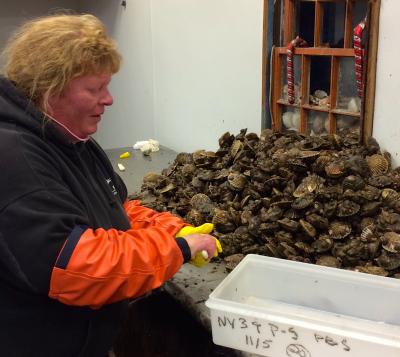Slow Start To The Scallop Season

“Not great” was, in short, the disappointing assessment of the bay scallop harvest in the first days of the season, which commenced in New York State waters on Monday.
A survey of those in the know, including baymen and seafood retailers, pointed to a slow start to the hotly anticipated delicacy’s harvest, which is authorized in state waters on the first Monday of November. Waters under the jurisdiction of the East Hampton Town Trustees will open to the harvesting of scallops on the coming Monday.
“Horrible,” was Kelly Lester’s assessment, speaking from her family’s scallop house on Abraham’s Path in Amagansett at midday Tuesday. “No one has gotten their limit.” The state’s Department of Environmental Conservation sets a limit of 10 bushels per day for holders of commercial permits and 20 bushels per boat. In trustee waters, the limit for commercial permittees is five bushels per day.
Whatever the reason for the scarcity of scallops, Ms. Lester said, “something is not right.” Danny Lester, her brother, called the first day’s take in the state waters of Northwest Harbor “not that great,” compared to last year.
Amanda Hayward, who scallops with her father, Jim Hayward, owner of Commander Cody’s Seafood on Shelter Island, said that they too harvested fewer scallops on Monday than on the first day of last year’s season. “But they are out there,” Ms. Hayward said. “You’ve just got to work a little extra to get them.”
Barley Dunne, director of the town’s shellfish hatchery, had a mixed appraisal of the harvest’s first days. The extreme cold and ice of last winter, he said, led to poor survival rates of the shellfish he and his team seed in local waters, in contrast with the previous year.
That said, “I saw quite a few boats in Northwest” on Monday, which Mr. Dunne called a positive indicator, and he personally harvested a bushel in little more than an hour while snorkeling off Noyac on Tuesday, reporting a high density of the bivalves there. “It sounds like it’s spotty — just a few spots where it’s worth dredging,” he said. “I don’t think it’s going to be as stellar as last year, but I don’t think it will be a total loss either.”
In town waters, Napeague Harbor “looks pretty sparse,” Mr. Dunne said, “but the gulls are finding them — they’re dropping them on our barge.” He said that he had seen “a fair amount” in Three Mile Harbor in East Hampton, and has heard anecdotes pointing to a healthy harvest there. “But I don’t think any place is necessarily carpeted like in the last few years.”
Bay scallop sales were “not a lot” as of Monday evening at the Seafood Shop in Wainscott, said Alex Fausto. While some 40 bushels, harvested from Orient Harbor and Peconic Bay, were waiting to be shucked, Mr. Fausto estimated the sale of about 40 pounds’ worth, a figure he said was less than half of a first day’s take in previous years.
More inquiries had come on Sunday, the first of the month, Mr. Fausto said, which he believed stemmed from confusion as to the date that scallops could be harvested. “It’s not like previous years,” he said, but added that “last year was kind of quiet at the beginning, then we got more and more” buyers.
“They’re very scarce,” said Charlotte Sasso of Stuart’s Seafood Market in Amagansett on Tuesday. The market was due to receive its first delivery of bay scallops, from the North Fork, on Tuesday night. “Everybody is so hungry for them,” Ms. Sasso said of her customers, but early reports were “not promising.”
Bay scallops would be available as of yesterday morning, she said, “and we’ll have them regularly as best we can, whatever we have to do.”
The harvesting season ends on March 31, though both the D.E.C. and the trustees extended the season through April this past year to accommodate harvesters whose income had been affected by the harsh winter conditions.
“People will get their scallops, but I don’t think it’s going to sustain itself into the New Year like a few years ago,” Mr. Dunne said. “These things are naturally cyclical, so we might be in a bit of a trough. Hopefully it will pick up again next year or the year after.”
With Reporting by Taylor K. Vecsey
